#Earth Core Rigel
Text
Prompt 218
“Moom, there’s yellow-eyed creeps fighting ninjas outside the window again!”
Danny sighed, taking a deep breath- in for ten, out for eight- as he set the pot he was cleaning back in the sink. Dan- currently six- came running in from the living room of the apartment, where he was watching TV. Or he should have been if not for the bullshit outside.
He sighed again, picking up baby Ellie- currently closer to two- out of her highchair (even if she could just float out) and let his oldest drag him to the window. Sure enough, another fight was happening, with no vigilante in sight stopping it. Look, he knew most people didn’t live here, but it was still rude.
“Jordan, remember how I told you how violence isn’t always the answer?” Danny asked sweetly, Dan’s expression shifting to a wicked grin as he opened the window. “Feel free to practice tossing some fireballs while I clean up your sister, yeah?”
Ah, the sweet sound of surprised cursing and startled ecto-signatures. Maybe they’d be polite enough to take their spar elsewhere.
#DCxDP#DPxDC#Danny: I’m going to be a better parent than my parents & not get distracted by work#He has a couple of the clones’ cores too#Does it count as mpreg?#Danny has a garden shop/bookstore at ground level#He’s gotten better at cooking but he doesn’t trust them not to come alive so he sticks to drinks#Halfas are like phoenixes when they have to retreat to their core#They come out as babies thanks to having to rebuild their human flesh body from scratch#Why yes they’re in Gotham- he’s lived in several different cities over the last few decades#Doesn’t look a day over thirty somehow (it’s the ectoplasm)#Space Core Danny#Sun Core Dan#Moon Core Ellie#Why yes he named his clone-sons after stars#Shadow Core Orion#Bed Sheet Ghost#Earth Core Rigel#Monster Ghost#Light Core Algor#Tiny Ghost#Sun Core Draco#Yes Danny is an adult with a pair of small children & 4 more on the way what of it#dad danny#Mom Danny#He is both#prompts
1K notes
·
View notes
Text
XAVIER: THE SUN
Xavier is the sun, but not in the way people think. People hear "sunshine character" and think of clear skies during spring. Of flowers and beaches and singing birds. But that's not Xavier. Xavier is the sun in a different way.
(This is all based on my own knowledge/memory of stars, and it's probably not perfectly accurate because I tend to forget things quickly. I'm also oversimplifying and heavily romanticizing this. This is not an academic paper. It's a silly little post about Love and Deepspace!)

The sun is an average size star compared to other stars in the universe. There are billions of smaller stars and billions of larger stars. Compared to stars like Rigel and Betelgeuse, the sun is just a speck of dust in space, and stars like Teegarden's Star and other red dwarfs are grains of sand compared to the sun. It's not particularly special in size.
It's classified as a yellow dwarf star. Yellow dwarf stars don't "go supernova". They don't turn into black holes or neutron stars. They are simply too small.
They burn out of their hydrogen supply over millions of years, collapse, then expand, turning into "red giants". They stay that way until they become unstable, shedding their outer layers in form of large clouds made up of dust and gas (called planetary nebula).
What is left afterwards is the core, a white dwarf. White dwarfs are very dense and do not produce heat. Instead they spend millions of years slowly cooling down. When they completely cool down they turn into black dwarfs, but we will never see one because the universe isn't old enough for a white dwarf to completely cool down and actually turn into one.
It's not special. Even its death will be slow and anticlimactic. It won't collapse into a supermassive black hole after a giant supernova. It will just fade away slowly and quietly after its life as a red giant is over.
What makes the sun special is not itself, but its perfect proximity to earth. The sun makes life here possible because its mass and distance to our home planet gave us a chance to exist and observe it. Nothing else. It is perfectly average in its size, luminosity, and mass.
The sun is also lonely. More than half of the stars that we have observed share a solar system with at least one other star. They orbit each other as they travel through the universe. We can also observe triple star systems (the nearest star to the sun, Proxima Centauri, is part of a triple star system as far as I remember), quadruple systems, and possibly even septuple star systems (Nu Scorpii and AR Cassiopeiae). I've even seen things about possible octuple and even nontuple star systems.
But the sun is alone. It has a lot of planets surrounding it, but no other stars accompany it. There's a chance that it has siblings though, stars that formed in the same nebulae/gas cloud, but we have trouble finding them because we don't even truly know in what nebulae the sun was "born" in.
We have theories, but it's hard to do anything except guess because our sun is quite old and therefore far away from its birthplace (which has probably stopped existing by now). We're looking for stars with similar compositions and ages as our sun, and we look at their orbits and compare them to the orbit of our sun to see if they could be related, all in hopes of finding out more about our star through them, but the search takes a lot of time. We might never find its siblings. Maybe they're just too far away. Or there are no siblings. Maybe the nebulae only gave birth to one star, our sun, and no others.
Maybe our sun was always destined to be alone, from the very beginning of its life to its end. And maybe Xavier is destined to be alone too.
151 notes
·
View notes
Photo

2023 April 7
Rigel Wide
Image Credit: Rheinhold Wittich
Explanation: Brilliant, blue, supergiant star Rigel marks the foot of Orion the Hunter in planet Earth's night. Designated Beta Orionis, it's at the center of this remarkably deep and wide field of view. Rigel's blue color indicates that it is much hotter than its rival supergiant in Orion the yellowish Betelgeuse (Alpha Orionis), though both stars are massive enough to eventually end their days as core collapse supernovae. Some 860 light-years away, Rigel is hotter than the Sun too and extends to about 74 times the solar radius. That's about the size of the orbit of Mercury. In the 10 degree wide frame toward the nebula rich constellation, the Orion Nebula is at the upper left. To the right of Rigel and illuminated by its brilliant blue starlight lies the dusty Witch Head Nebula. Rigel is part of a multiple star system, though its companion stars are much fainter.
∞ Source: apod.nasa.gov/apod/ap230407.html
89 notes
·
View notes
Text
A common apologia for STAR TREK — particularly TOS, but extending to the newest shows as well — is that it wants or tries to be progressive, but is tripped up by the writers' unconscious biases or the ostensibly more backward social attitudes of its time (whatever time that may be). This argument is somewhat perplexing because STAR TREK has never been what you'd call subtle in expressing its liberal imperialist values, either in 1966–1968 or now.
The core of STAR TREK, which is explained clearly in Roddenberry's pitch and the TOS writer's bible (excerpted at some length in Stephen Whitfield's THE MAKING OF STAR TREK, inter alia), is a hybridization of Horatio Hornblower, the C.S. Forester adventure novels about a heroic British naval officer during the Napoleonic wars, and the American Western, a genre that still dominated a big swath of American TV drama in the period when STAR TREK was conceived. Roddenberry himself had previously written for some of those shows, in particular HAVE GUN, WILL TRAVEL, and his pitch line for STAR TREK was "WAGON TRAIN to the stars."
To its credit, STAR TREK ended up being about more than just that, but Roddenberry was very clear that at heart, the series was about extending the conquest of the American frontier to the stars. Of the Enterprise and the other ships of its class, Roddenberry said:
In addition to the twelve Starships, there are lesser classes of vessels, capable of operating over much more limited distances. They are involved in commercial ventures, survey work, archaeological expeditions, medical research, and so on. The Starships are the heavy cruisers, the ones which can best defend themselves as they probe farther and farther out, opening new areas … and then the others follow. [Whitfield, 204; emphasis added]
Because TOS avoids saying anything very substantive about civilian life and government outside of Starfleet, we actually know very little about factors may be driving this wave of colonialism. If Earth in the TOS-era is a post-scarcity paradise (which, it should be noted, the original show does not ever actually say), why leave home for a riskier, hardscrabble life on worlds like Rigel XII ("Mudd's Women") or Cestus III ("Arena")? Part of it is plainly capitalist interests: There are explicitly opportunities to strike it rich discovering or exploiting valuable resources (or fleecing those who have or hope to, as Harry Mudd does). The Federation is also keen to cement its political hold on worlds that are near the borders of rival empires; the plot of "The Trouble with Tribbles," for example, hinges on the Federation's determination to colonize Sherman's Planet, which is also claimed by the Klingon Empire.
However, these plot details are to some extent beside the point: The premise of STAR TREK, and of most Westerns, is that the importance and heroic necessity of colonizing and "developing" the frontier, bringing (white) civilization to the "savage" wilderness, is self-evident.
Much of STAR TREK is predicated on concepts of "social evolution," the idea that there are a series of consistently defined hierarchical stages from the primitive to the advanced. TOS often states this quite explicitly, but it has remained a key feature of the STAR TREK premise up to the present. This process of advancement is described as both natural and a matter of moral urgency: Kirk rails against the "stagnation" of less-advanced societies, and on multiple occasions argues that the importance of reversing stagnation (or devolution) justifies violating the Prime Directive with dramatic interventionist action to put a civilization back on what he considers the proper track.
The concepts of social evolution STAR TREK espouses are fundamentally racist — it's a philosophy that rationalizes colonial exploitation (and in the real world even slavery) — and play into the franchise's virulent anti-indigenous attitudes. Indeed, STAR TREK frequently takes an openly contemptuous view of "primitive" peoples, who in TOS are often presented as simpletons, either kindly child-men (e.g., "The Apple") or dangerous savages driven by quasi-animal cunning (as with some of the characters in "A Private Little War"). Probably the ugliest example in TOS is "The Paradise Syndrome, where Kirk loses his memory and falls in with a society of American Indians transported centuries earlier to a distant planet; the story emphasizes that, even deprived of the knowledge and technology of his century, Kirk is still the intellectual superior of the people around him (who of course are played by white actors in redface). However, this a recurring theme throughout STAR TREK: Indigenous species are consistently presented as something less than people unless their stage of advancement approximates that of 20th century Earth (as with the Roman proconsul in "Bread and Circuses," who is one of the very few indigenous "primitives" to be credited with any kind of intellectual sophistication). The application of the Prime Directive (which is wildly inconsistent and honored more in the breach than in the observance) is based not on respect for cultural differences, but on a patronizing desire to "protect" indigenous pre-warp civilizations from ideas that their primitive minds can't yet handle.
STAR TREK pays lip service to the idea of cultural and racial diversity, and the Vulcan slogan (in the third season of TOS) "Infinite Diversity in Infinite Combinations." However, what it most consistently espouses is the importance of ensuring the march of social evolution along orthodox lines and the eventual absorption of other races, cultures, and species into the Federation's (white American liberal) ideas of socioeconomic and technological progress. As Kirk says to Ayelborne in "Errand of Mercy":
KIRK: Gentlemen, I must get you to reconsider. We can be of immense help to you. In addition to military aid, we can send you specialists, technicians. We can show you how to feed a thousand people where one was fed before. We can help you build schools, educate the young in the latest technological and scientific skills. Your public facilities are almost nonexistent. We can help you remake your world, end disease, hunger, hardship. All we ask in return is that you let us help you. Now.
"Errand of Mercy" is notable in that Kirk's condescension toward the Organians proves to be ill-founded: What he and Spock assumed was a stagnant, primitive society is actually a kind of backyard bird feeder maintained by a vastly more advanced species that is trying very hard to be patient as Kirk and the Klingons strut around making pronouncements. At the end of the episode, Kirk admits openly that he's embarrassed at how badly he misread the situation. However, this doesn't ultimately lead him to question his presumptions about social progress; he simply admits that in this specific case, they were misapplied.
The result of "Errand of Mercy," as revealed in the second season of TOS, is a peace treaty between the Federation and Klingons that makes the show's endorsement of colonialism and economic imperialism that much clearer: As we're told in "The Trouble with Tribbles," under this new treaty, if there is a territorial dispute over a newly discovered or colonized world, "one side or the other must prove it can develop the planet most efficiently," with the ostensibly benevolent and freedom-loving Federation and the ostensibly "brutal and aggressive" Klingon Empire vying to determine who will be permitted to exploit that world and its resources. The exact role of the Organians in the framing of this treaty is unclear — they have no need of or interest in Federation-style economic development, and nothing in "Errand of Mercy" suggests that they see much value in it, although the Organians do say they find the prospect of a shooting war between the Federation and the Klingon Empire both morally objectionable and "intensely painful" — but its result is to more firmly establish the Cold War conflict between the Federation and Klingons as the competition of two rival colonial powers for control of valuable territory and resources. Their conflict is a primarily economic one, not really substantively based on what Kor calls the "minor ideological differences" between the two empires, which both Kor and the Organians regard as incidental. (Kirk takes issue with that contention, but as previously noted, Kirk has more than once used the explicit threat of planetary genocide to get what he wants, so Kor probably has a point here!)
Later STAR TREK shows are sometimes more self-conscious about these values, but they seldom actually question them, and there's really only so far that STAR TREK can move these load-bearing narrative elements without becoming something really fundamentally different than it is. Moreover, DISCOVERY, STRANGE NEW WORLDS, and PICARD have seemed committed to doubling down on many of the franchise's more disturbing ideological elements, while attempting to paper over viewer unease with appeals to nostalgia, faux-patriotism, and sentimentality.
#teevee#star trek#star trek tos#the making of star trek#gene roddenberry#stephen whitfield#errand of mercy#organians#the paradise syndrome#anti-indigenous racism
14 notes
·
View notes
Text

@ExploreCosmos_: Rigel is the brightest star in the constellation of Orion and the seventh brightest star in the night sky. Its name originates from the Arabic word for "foot" or "leg," reflecting its position as the foot of Orion, the mighty hunter of Greek mythology. 2/ With a visual magnitude of about 0.13, Rigel shines fiercely, illuminating its surrounding cosmic neighborhood. Rigel belongs to the spectral class B8Ia, indicating that it is a massive, luminous star with a surface temperature of approximately 11,000 Kelvin. 3/It is estimated to be around 21 times the mass of the Sun and roughly 78 times its radius. Such immense proportions classify Rigel as a blue supergiant. Rigel's luminosity is staggering, with a brightness approximately 120,000 times that of the Sun. 4/Being a blue supergiant, Rigel burns through its nuclear fuel at a rapid pace. As a result, it has a relatively short lifespan compared to smaller, less luminous stars. Estimates suggest that Rigel is only a few million years old & is already nearing the end of its life cycle. 5/ Rigel does not exist in isolation; it is part of a larger stellar system that adds complexity and intrigue to its celestial narrative. Rigel has a companion star, Rigel B, which is often overlooked due to the brilliance of its primary counterpart. 6/Rigel B is itself a spectroscopic binary system, consisting of two stars orbiting around a common center of mass. These stars are likely smaller and less massive than Rigel A, contributing to the overall dynamics of the system. 7/ While no confirmed exoplanets have been discovered in the immediate vicinity of Rigel, astronomers continue to investigate the possibility of planetary companions around this massive star. The intense radiation and stellar winds emitted by Rigel pose challenges for the ... 8/ formation and stability of planetary systems. However, theoretical models suggest that distant gas giants or rocky worlds may orbit within the habitable zone of Rigel, albeit under extreme conditions. 9/Rigel's radiance also illuminates the surrounding interstellar medium, shaping intricate structures such as the Witch Head Nebula. This nebula, located approximately 900 light-years away, reflects the intense ultraviolet radiation emitted by Rigel, creating a ... 10/ stunning cosmic vista for observers on Earth. Rigel's prominence extends beyond its celestial beauty; it serves as a crucial object of study for astronomers seeking to unravel the mysteries of stellar evolution, nucleosynthesis, and the dynamics of stellar systems. 11/ As a blue supergiant approaching the later stages of its life, Rigel offers valuable insights into the fate of massive stars. Scientists observe its behavior to understand processes such as core fusion, mass loss, and eventual supernova explosions, ... 12/which enrich the cosmos with heavy elements essential for the formation of new stars & planetary systems. We employ a variety of observational techniques, including spectroscopy & photometry, to analyze Rigel's spectrum, luminosity variations & physical properties. These observations deepen our understanding of stellar atmospheres, interior structure, and evolutionary pathways, contributing to broader theories of stellar evolution and galactic dynamics. 14/ With advancements in astronomical instrumentation and space exploration technology, researchers anticipate further discoveries and insights into the Rigel system. Future missions may include detailed spectroscopic studies, direct imaging of potential exoplanets, ... 15/and enhanced simulations to model the complex interactions within this dynamic stellar environment. Rigel stands as a beacon of cosmic wonder, captivating observers with its brilliance and scientific significance.
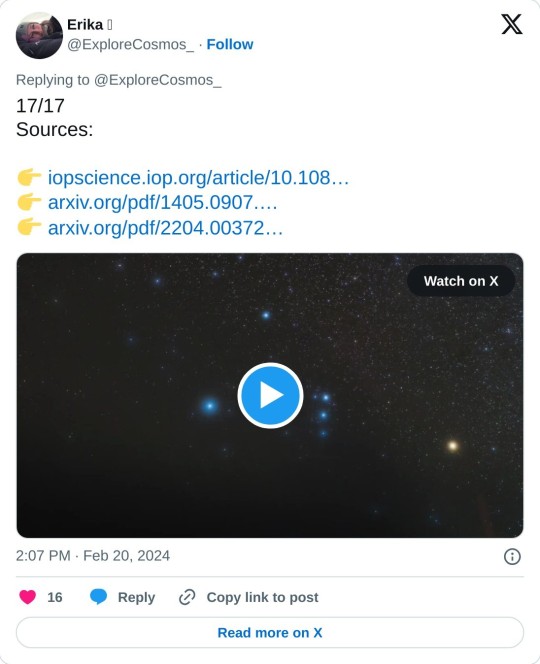
2 notes
·
View notes
Photo
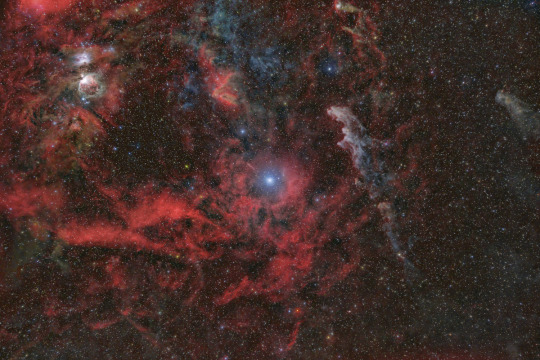
Rigel Wide via NASA https://ift.tt/VKMeUpC
Brilliant, blue, supergiant star Rigel marks the foot of Orion the Hunter in planet Earth's night. Designated Beta Orionis, it's at the center of this remarkably deep and wide field of view. Rigel's blue color indicates that it is much hotter than its rival supergiant in Orion the yellowish Betelgeuse (Alpha Orionis), though both stars are massive enough to eventually end their days as core collapse supernovae. Some 860 light-years away, Rigel is hotter than the Sun too and extends to about 74 times the solar radius. That's about the size of the orbit of Mercury. In the 10 degree wide frame toward the nebula rich constellation, the Orion Nebula is at the upper left. To the right of Rigel and illuminated by its brilliant blue starlight lies the dusty Witch Head Nebula. Rigel is part of a multiple star system, though its companion stars are much fainter.
7 notes
·
View notes
Text
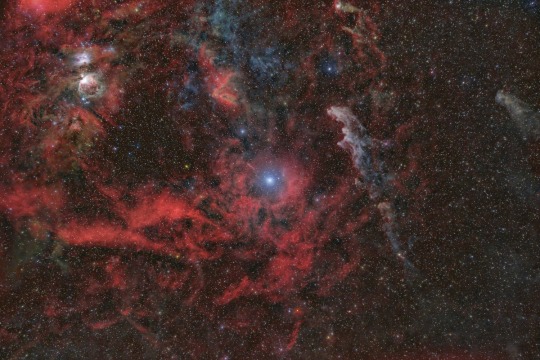
APOD: Rigel Wide (4/7/23)
Brilliant, blue, supergiant star Rigel marks the foot of Orion the Hunter in planet Earth's night. Designated Beta Orionis, it's at the center of this remarkably deep and wide field of view. Rigel's blue color indicates that it is much hotter than its rival supergiant in Orion the yellowish Betelgeuse (Alpha Orionis), though both stars are massive enough to eventually end their days as core collapse supernovae. Some 860 light-years away, Rigel is hotter than the Sun too and extends to about 74 times the solar radius. That's about the size of the orbit of Mercury. In the 10 degree wide frame toward the nebula rich constellation, the Orion Nebula is at the upper left. To the right of Rigel and illuminated by its brilliant blue starlight lies the dusty Witch Head Nebula. Rigel is part of a multiple star system, though its companion stars are much fainter.
0 notes
Text
Brilliant, blue, supergiant star Rigel marks the foot of Orion the Hunter in planet Earth's night. Designated Beta Orionis, it's at the center of this remarkably deep and wide field of view. Rigel's blue color indicates that it is much hotter than its rival supergiant in Orion the yellowish Betelgeuse (Alpha Orionis), though both stars are massive enough to eventually end their days as core collapse supernovae. Some 860 light-years away, Rigel is hotter than the Sun too and extends to about 74 times the solar radius. That's about the size of the orbit of Mercury. In the 10 degree wide frame toward the nebula rich constellation, the Orion Nebula is at the upper left. To the right of Rigel and illuminated by its brilliant blue starlight lies the dusty Witch Head Nebula. Rigel is part of a multiple star system, though its companion stars are much fainter.
📷: Rheinhold Wittich

0 notes
Text
100,000 years ago The Pleiadians, a group from the Seven Sisters star system, were needed to alter your DNA, which was done fairly recently. You were at that point where you were beginning to develop many kinds of Humans, just as most of the mammals of Earth have done. The first thing they did was to stop the development of all the branches of Humans but one. the kind you have now. The second thing they did was to alter the genetic code of the Humans who would be the core race. This alteration would create a genetic "imprint of God" in each of you, since they carried that too. (Kryon)
100,000 years ago Mintaka became the central point in Orion's enlightened government following the resolution of the Rigel-Betelguese wars.
100,000 years ago Twenty kinds of Human Beings were in development. There were several places where they were being developed faster than others and your anthropologists know of those. It didn't start in one place on the planet. They were in places that you would call Western Europe, or the Middle East and another unusual place - the middle of the Pacific Ocean!
Evolution was slowly creating many kinds of Human Beings, just like nature does with everything. Then the planet was touched by design - sacred design.
0 notes
Text
The Lives, Times, and Deaths of Stars
Who among us doesn’t covertly read tabloid headlines when we pass them by? But if you’re really looking for a dramatic story, you might want to redirect your attention from Hollywood’s stars to the real thing. From birth to death, these burning spheres of gas experience some of the most extreme conditions our cosmos has to offer.

All stars are born in clouds of dust and gas like the Pillars of Creation in the Eagle Nebula pictured below. In these stellar nurseries, clumps of gas form, pulling in more and more mass as time passes. As they grow, these clumps start to spin and heat up. Once they get heavy and hot enough (like, 27 million degrees Fahrenheit or 15 million degrees Celsius), nuclear fusion starts in their cores. This process occurs when protons, the nuclei of hydrogen atoms, squish together to form helium nuclei. This releases a lot of energy, which heats the star and pushes against the force of its gravity. A star is born.
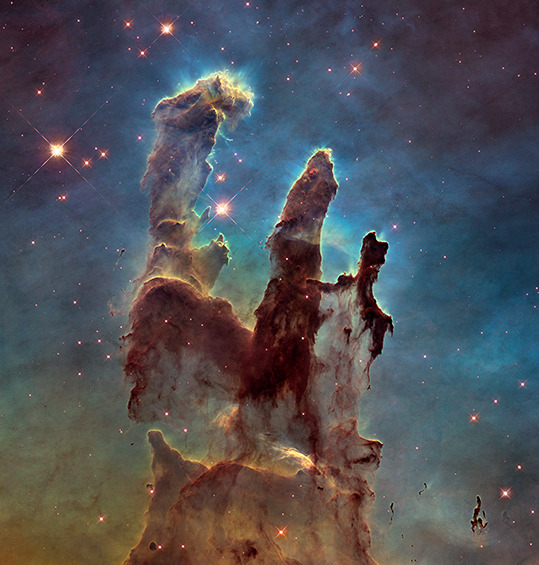
Credit: NASA, ESA and the Hubble Heritage Team (STScI/AURA)
From then on, stars’ life cycles depend on how much mass they have. Scientists typically divide them into two broad categories: low-mass and high-mass stars. (Technically, there’s an intermediate-mass category, but we’ll stick with these two to keep it straightforward!)
Low-mass stars

A low-mass star has a mass eight times the Sun's or less and can burn steadily for billions of years. As it reaches the end of its life, its core runs out of hydrogen to convert into helium. Because the energy produced by fusion is the only force fighting gravity’s tendency to pull matter together, the core starts to collapse. But squeezing the core also increases its temperature and pressure, so much so that its helium starts to fuse into carbon, which also releases energy. The core rebounds a little, but the star’s atmosphere expands a lot, eventually turning into a red giant star and destroying any nearby planets. (Don’t worry, though, this is several billion years away for our Sun!)

Red giants become unstable and begin pulsating, periodically inflating and ejecting some of their atmospheres. Eventually, all of the star’s outer layers blow away, creating an expanding cloud of dust and gas misleadingly called a planetary nebula. (There are no planets involved.)

Credit: NASA, ESA, and the Hubble Heritage Team (STScI/AURA)
All that’s left of the star is its core, now called a white dwarf, a roughly Earth-sized stellar cinder that gradually cools over billions of years. If you could scoop up a teaspoon of its material, it would weigh more than a pickup truck. (Scientists recently found a potential planet closely orbiting a white dwarf. It somehow managed to survive the star’s chaotic, destructive history!)

High-mass stars
A high-mass star has a mass eight times the Sun’s or more and may only live for millions of years. (Rigel, a blue supergiant in the constellation Orion, pictured below, is 18 times the Sun’s mass.)
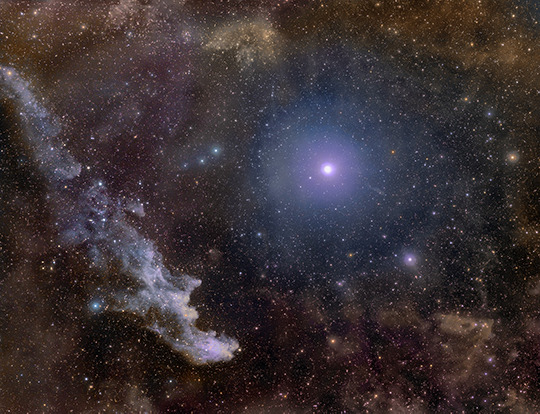
Credit: Rogelio Bernal Andreo
A high-mass star starts out doing the same things as a low-mass star, but it doesn’t stop at fusing helium into carbon. When the core runs out of helium, it shrinks, heats up, and starts converting its carbon into neon, which releases energy. Later, the core fuses the neon it produced into oxygen. Then, as the neon runs out, the core converts oxygen into silicon. Finally, this silicon fuses into iron. These processes produce energy that keeps the core from collapsing, but each new fuel buys it less and less time. By the point silicon fuses into iron, the star runs out of fuel in a matter of days. The next step would be fusing iron into some heavier element, but doing requires energy instead of releasing it.
The star’s iron core collapses until forces between the nuclei push the brakes, and then it rebounds back to its original size. This change creates a shock wave that travels through the star’s outer layers. The result is a huge explosion called a supernova.

What’s left behind depends on the star’s initial mass. Remember, a high-mass star is anything with a mass more than eight times the Sun’s — which is a huge range! A star on the lower end of this spectrum leaves behind a city-size, superdense neutron star. (Some of these weird objects can spin faster than blender blades and have powerful magnetic fields. A teaspoon of their material would weigh as much as a mountain.)
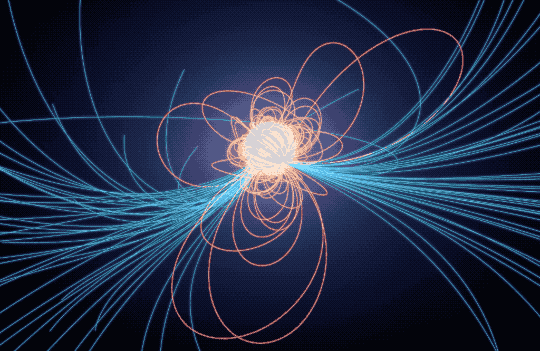
At even higher masses, the star’s core turns into a black hole, one of the most bizarre cosmic objects out there. Black holes have such strong gravity that light can’t escape them. If you tried to get a teaspoon of material to weigh, you wouldn’t get it back once it crossed the event horizon — unless it could travel faster than the speed of light, and we don’t know of anything that can! (We’re a long way from visiting a black hole, but if you ever find yourself near one, there are some important safety considerations you should keep in mind.)
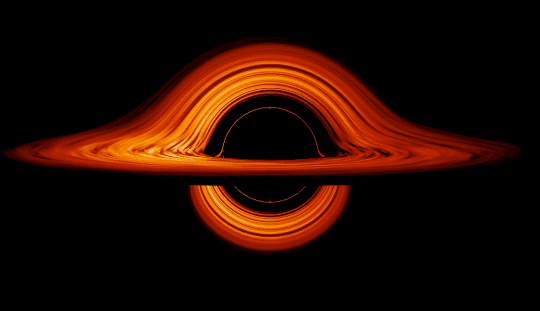
The explosion also leaves behind a cloud of debris called a supernova remnant. These and planetary nebulae from low-mass stars are the sources of many of the elements we find on Earth. Their dust and gas will one day become a part of other stars, starting the whole process over again.
That’s a very brief summary of the lives, times, and deaths of stars. (Remember, there’s that whole intermediate-mass category we glossed over!) To keep up with the most recent stellar news, follow NASA Universe on Twitter and Facebook.
Make sure to follow us on Tumblr for your regular dose of space: http://nasa.tumblr.com.
4K notes
·
View notes
Photo
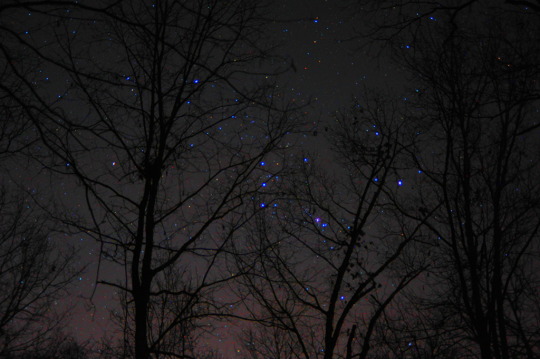
The Fainting of Betelgeuse : Begirt with many a blazing star, Orion the Hunter is one of the most recognizable constellations. In this night skyscape the Hunter's stars rise in the northern hemisphere's winter sky on December 30, 2019, tangled in bare trees near Newnan, Georgia, USA. Red super giant star Betelgeuse stands out in yellowish hues at Orion's shoulder left of center, but it no longer so strongly rivals the blue supergiant star Rigel at the Hunter's foot. In fact, skygazers around planet Earth can see a strikingly fainter Betelgeuse now, its brightness fading by more than half in the final months of 2019. Betelgeuse has long been known to be a variable star, changing its brightness in multiple cycles with approximate short and long term periods of hundreds of days to many years. The star is now close to its faintest since photometric measurements in 1926/27, likely due in part to a near coincidence in the minimum of short and long term cycles. Betelgeuse is also recognized as a nearby red supergiant star that will end its life in a core collapse supernova explosion sometime in the next 1,000 years, though that cosmic cataclysm will take place a safe 700 light-years or so from our fair planet. via NASA
701 notes
·
View notes
Text
The Family!
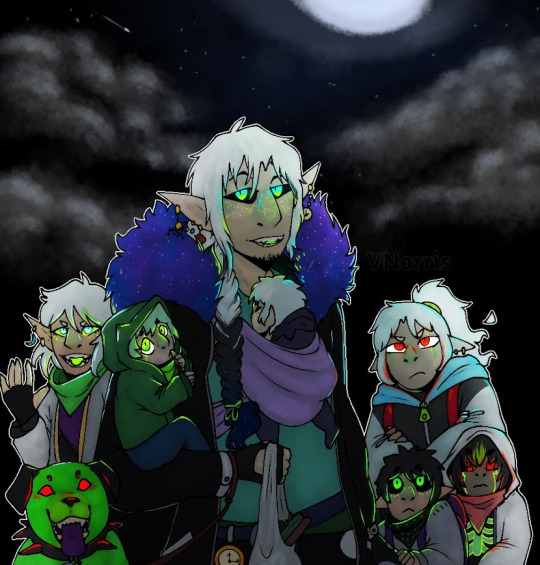
All on a 3am snack run, about to terrorize some idiots. Or the local vigilantes if its a crossover. Could they hypothetically go shopping at any time in any dimension? Yes. Do they accidentally became 3am cryptids? .... Perhaps...
From left to right:
Ellie (16, Moon Core)
Algor/Tiny Ghost (4, Light Core)
Draco/Perfect Clone (1, Ice Core)
Jordan (13, Sun Core)
Rigel/Monster Ghost (6, Earth Core)
Orion/Bedsheet Ghost (9, Shadow Core)
#Phantom Family#My art#space core danny#mom danny#dad danny#he is both#Space Core Danny#Sun Core Dan#Moon Core Ellie#Why yes he named his clone-sons after stars#Shadow Core Orion#Bed Sheet Ghost#Earth Core Rigel#Monster Ghost#Light Core Algor#Tiny Ghost#Ice Core Draco#Honestly feel free to use this as like a prompt thing lol#Also feel free to do crossover#danny phantom#danny fenton#dani phantom#not ghost king danny#dark danny#dan phantom#danielle phantom#danny fenton clones#de aged dan#de aged ellie#adult danny
348 notes
·
View notes
Video
vimeo
Magnificent timelapse work with the night sky. Original caption below with many more details:
As the days shorten and the darkness progressively eats away the light, an amazing transformation happens in the northern hemisphere skies. A lot of astronomers and stargazers prefer summertime to look up at the stars, probably because conditions are better and the brightest part of our own galaxy, the milky way is more visible, even with the naked eye. Although fainter, the ‘winter’ part of the milky way and the rest of the winter sky harbor countless unsuspected gems, if one knows how to find and capture them!
In the late Fall, you can still get a glimpse at the bright core of our galaxy sink down under the horizon just after sunset, along with its dark hydrogen gas lanes, Lagoon and trifid nebulae, and Saturn. Later, you can catch Scutum (shield constellation) and its dark nebulosity set in the south west/west. In the movie, this part is visible in many scenes but my favorite one is by far as it sets on La Palma shores behind a thunderstorm accompanied by red sprites, airglow and zodiacal lights.Then, take a peek at one of my favorite areas of the winter sky: the Swan constellation. I presented it to you (also on the cover), so that you can see it from different perspectives, but the best is probably at a narrower angle to show the beautiful magenta colors of the H-alpha emission nebulae (North-American, Pelican, Sadr region or IC 1396). I also included a scene where the ‘Summer Triangle’ of Cygnus (formed by Deneb, Sadr, Delta Cygni, and Gienah) is photobombed by an overhead aurora borealis. Continuing along the winter milky way, I included a shot of the Heart and Soul nebula. Rising on the other side of the hemisphere, we are now looking at the outer edge of our galaxy, where very little light comes from fewer stars, nebulae and dark clouds (in comparison to the core!). I wanted to show you a very novel scene combining the hot Pleiades stars reflecting their blue light onto passing gasses and the California nebula glowing blood red! The next area I want to emphasize is winter’s most emblematic: Orion. I wanted to maximize the different colors and brightness this constellation has to offer while shooting it in a series of single shots: the orange of Betelgeuse and the blue of Rigel, the gigantic red-glowing Barnard’s loop, the inevitable shell-like Orion nebula along with the running man nebula, the horse-head nebula, the flame nebula, Lambda Orionis nebula… Further away from the winter milky way doesn’t mean dull at all, au contraire! Look at the magnificent Andromeda galaxy (M31), the size of 6 full moons- rise above the tree line! What about the iconic Big Dipper being photobombed by some pillars of Icelandic and Canadian aurora borealis? What about these iridescent marbles at the very start of the video? Those are twinkling Sirius, Capella (bottom left) and Vega (upper right) emphasized by the real-time out-of-focus setting to reveal the hypnotic shift in light and colors of these twinkling stars created by our own atmosphere! You will probably miss a lot of night sky events if you only watch the video once! Don’t blink, you might miss a lot of meteors (Perseids, Orionids, Draconids, Leonids…), iridium flares, low-orbit satellites, red sprites. What about those satellites that seem to ‘follow’ each other in some deep-sky scenes? Those are geosynchronous satellites normally hovering over a fixed point of the Earth, but the motion of the star tracker allows them to move whereas the sky is now immobile. I am sure professionals and amateurs will spot many more features, all you have to do is sit back and gaze!
The goal of this series of astro-lapses ‘Galaxies’ and especially this second opus was a way for me to push the limits of single astrophotography. However beautiful and numerous they are, wide-angle shots of the milky way moving against a foreground became less interesting to me as I got to shoot more and more astro-timelapses. I became more interested in exploring the possibilities that modern lenses, sensors and techniques could give, so I started using medium-format and astromodfication to take advantage of a wider light spectrum and show the red colors of H-alpha emission nebulae that are so ubiquitous in the winter part of the sky. I also wanted to improve the quality of the shots, so I used a square light pollution filter for shots at more than 50mm (Lonely Speck’s Pure Night LP filter), and a star tracker for some of the scenes to increase sharpness and details (Vixen Polarie). It was very important for me to prove that deep-sky time-lapses can be very interesting and successful, whether they hold a foreground or not, because so many things can be happening the sky (airglow, meteors, satellites, haze giving a temporary glow to the stars…). All shots have been recorded over the past year and in different countries (France, Switzerland, Spain, Iceland, Denmark and Canada). I will gladly give more details upon request. Thanks a lot for watching!
#timelapse#night sky#galaxy#astronomy#dark sky#satellite#meteor#sprite#milky way#video#vimeo#the universe#the real universe
58 notes
·
View notes
Photo
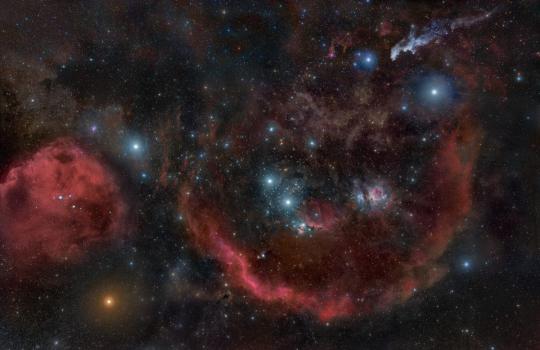
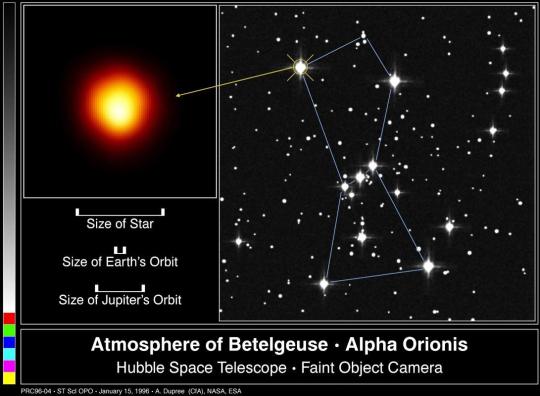

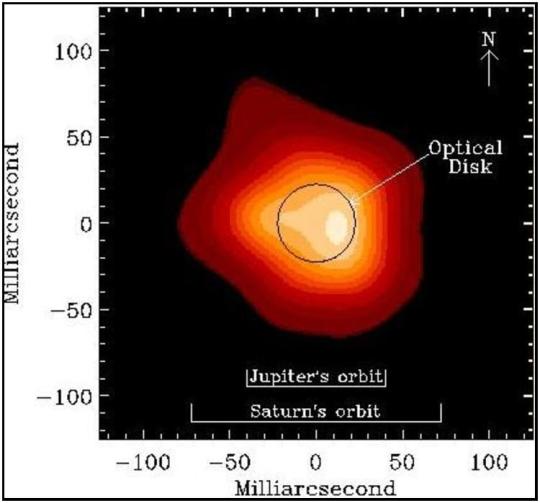
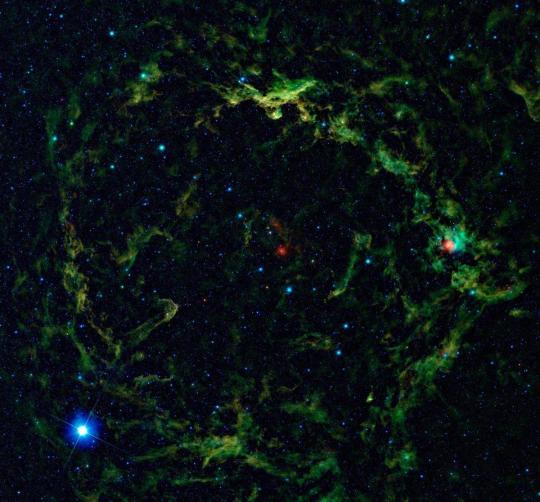
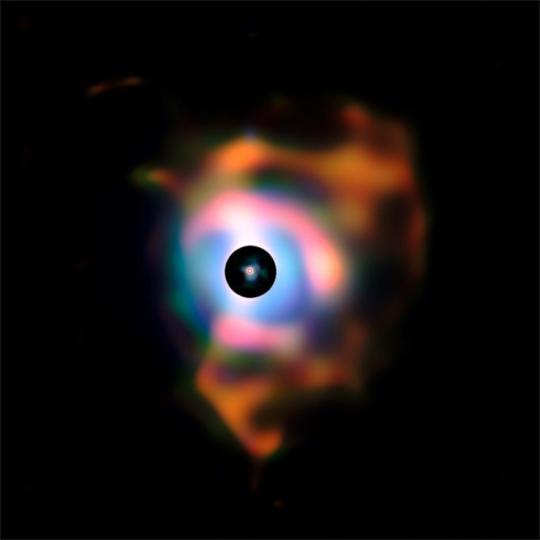




Is Betelgeuse About To Explode?
“Unfortunately, though, the key question of exactly when Betelgeuse is going to go supernova is one that we're not any closer to having an answer to. Until we can measure the processes occurring in the star's core, which would require a neutrino telescope far more powerful than all the neutrino observatories on Earth combined, we cannot know which elements are being fused inside of it.
Right now, our best models are consistent with helium-burning rather than any of the heavier elements, indicating that we have at least hundreds of years — and possibly hundreds of thousands — until the inevitable supernova finally detonates. If you haven't checked out the constellation of Orion recently, though, take a good look and notice how much dimmer red Betelgeuse is than blue Rigel, a severe departure from its past decade of appearances. A supernova may not be imminent, but is sure is fascinating to watch and hope!”
Is Betelgeuse about to explode? Probably not, but we cannot be sure.
Want to know what astronomers know so far? Get the fascinating story today, and go see what it’s doing with your own naked eye!
126 notes
·
View notes
Photo
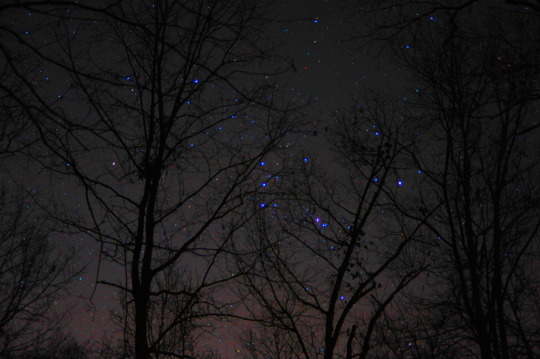
2020 January 2
The Fainting of Betelgeuse
Image Credit & Copyright: Jimmy Westlake (Colorado Mountain College)
Explanation: Begirt with many a blazing star, Orion the Hunter is one of the most recognizable constellations. In this night skyscape the Hunter's stars rise in the northern hemisphere's winter sky on December 30, 2019, tangled in bare trees near Newnan, Georgia, USA. Red super giant star Betelgeuse stands out in yellowish hues at Orion's shoulder left of center, but it no longer so strongly rivals the blue supergiant star Rigel at the Hunter's foot. In fact, skygazers around planet Earth can see a strikingly fainter Betelgeuse now, its brightness fading by more than half in the final months of 2019. Betelgeuse has long been known to be a variable star, changing its brightness in multiple cycles with approximate short and long term periods of hundreds of days to many years. The star is now close to its faintest since photometric measurements in 1926/27, likely due in part to a near coincidence in the minimum of short and long term cycles. Betelgeuse is also recognized as a nearby red supergiant star that will end its life in a core collapse supernova explosion sometime in the next 1,000 years, though that cosmic cataclysm will take place a safe 700 light-years or so from our fair planet.
∞ Source: apod.nasa.gov/apod/ap200102.html
102 notes
·
View notes
Photo
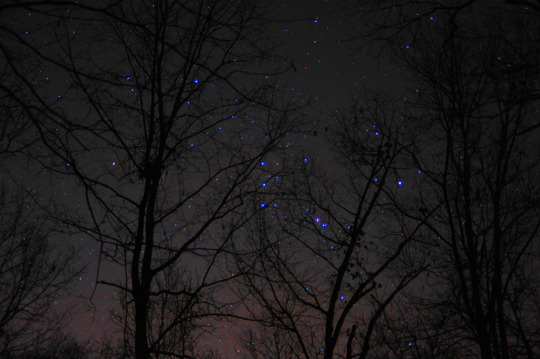
The Fainting of Betelgeuse
Image Credit & Copyright: Jimmy Westlake (Colorado Mountain College)
Begirt with many a blazing star, Orion the Hunter is one of the most recognizable constellations. In this night skyscape the Hunter's stars rise in the northern hemisphere's winter sky on December 30, 2019, tangled in bare trees near Newnan, Georgia, USA. Red super giant star Betelgeuse stands out in yellowish hues at Orion's shoulder left of center, but it no longer so strongly rivals the blue supergiant star Rigel at the Hunter's foot. In fact, skygazers around planet Earth can see a strikingly fainter Betelgeuse now, its brightness fading by more than half in the final months of 2019. Betelgeuse has long been known to be a variable star, changing its brightness in multiple cycles with approximate short and long term periods of hundreds of days to many years. The star is now close to its faintest since photometric measurements in 1926/27, likely due in part to a near coincidence in the minimum of short and long term cycles. Betelgeuse is also recognized as a nearby red supergiant star that will end its life in a core collapse supernova explosion sometime in the next 1,000 years, though that cosmic cataclysm will take place a safe 700 light-years or so from our fair planet.
https://apod.nasa.gov/apod/ap200102.html?fbclid=IwAR3OsHHZ7j4FvdkwGmTtu0-6Dxe9lEedYtmjlr_L-QcoMoxidTnYSDfaylE
14 notes
·
View notes